Narthaki

News

Info

Featured

 |
  |
Parwati Dutta: Following the heart - Padma Jayaraj, Thrissur e-mail: padmajayaraj@gmail.com December 7, 2012 I saw her amidst dance students assembled for a workshop on Kathak, sponsored by the Sangeet Nataka Akademi, Kerala, in Thrissur. She was distinguishing different dance forms by showing just the neck movements, in Bharatanatyam, Mohiniattam, Kathak, Kuchipudi and Odissi as a unit of gestural vocabulary. 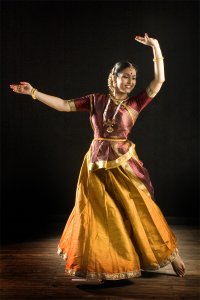 Parwati Dutta (Kathak) "Dance is visual poetry," she painted with her hands in the air, colored with the emotions on her face. Her knowledge of the aesthetics of the wide variety of dance forms found in India was impressive. Parwati Dutta introduced herself to the students as the daughter of a Punjabi mother and Bengali father, who was fortunate enough to spend her childhood in a neighborhood in Kolkata and then in Bhopal where many south Indians lived. Her exposure to a multicultural life, of colorful festivities in an impressionable period must have shaped her formative years. 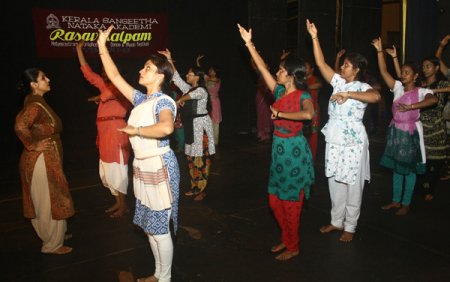 Class at Rasavikalpam, Thrissur Photo: Manoj Ksna She introduced the basics of Kathak, its circular and spiral movements, its technique of footwork competing with the percussion playing various sound patterns. Her comparisons with other forms opened window views. She recalled the ideas she received from her gurus Pt Birju Maharaj, Kelucharan Mohapatra and Madhavi Mudgal. Enlivened with anecdotes, enriched by different perceptions, the workshop went on for four days and everyone longed to see her perform on stage. One evening, seated across a coffee table she recollected her training in childhood. Her parents (both engineers by profession) coming from families of writers, thinkers and reformists recognized culture as the building blocks to create a harmonious personality. Her tottering steps, by four, steadied into rhythmic movements. Her heartbeat synchronized with the percussion, which enabled her to gain expertise in pakhawaj. They took her to the portals of Sanskrit which later helped her chart her course in the ocean that is Indian dance. She grew up into an accomplished artiste that made her quit her engineering stream in college. Following her heart, she went to Delhi for further dance training. Her Delhi days saw her living as performer, teacher and researcher. Working on a project, a multimedia exhibit on Gita Govind, and meeting other artists in other fields gave her fresh insights. There was scope for advancement and career building in the capital of India. But, something was gnawing at her heart, the need to accomplish a task. It was a god given chance when the Mahatma Gandhi Mission, a charitable organization in Aurangabad, asked her help to start a Gurukul. Soon a small town became her centre stage. Started in 1996, Mahagami Gurukul is growing in leaps and bounds. Under her guidance, Mahagami is a sacred space for outstanding works, of holistic teaching of India's classical dance and music. Apart from teaching Kathak and Odissi, dhrupad and pakhawaj, concerts by great masters and other teaching initiatives through festivals, residency programs are its regular features. Today as a member of the International Dance Council, UNESCO, Mahagami forms a unique synthesis of modern technological aids and an intense value based training system of ancient Gurukul. Parwati's vision encompasses disseminating Indian aesthetics. Creation of productions and performances, research of texts, and documentation to suit changing needs are her means. Anubhuti is a multimedia dance awareness program, an interactive presentation aimed at educational, social and corporate organizations. "Even the police in their academy enjoyed and felt elated through the program," she said of her experience. "My dream is to create a culturally awakened society." Working among rural population, crusading against Bollywood hit numbers by creating a platform for traditional art forms has become her mission. Spiritually connected to Mahagami, she is establishing outreach centers in Pune and rural areas of Aurangabad. Her students are an asset now joining her endeavor. She encourages interdisciplinary subjects like dance therapy, yoga and martial arts, vocal and instrumental music, theory of arts to mention a few. One of her students Vinodini is doing research in the Philosophy Dance in Oxford University. The relentless quest of Parwati Dutta to discover concepts related to art and philosophy enhances her productions. Her dance productions range from traditional concepts to narrative, contemplative and research themes many of them performed at major national and international festivals. Sapta Sandhi, with 2 dance productions Nirgeet and Sannidhi is an amalgam of seven dance traditions - Kathakali, Kathak, Odissi, Manipuri, Bharatanatyam, Kuchipudi and Mohiniattam. Sannidhi is cast in the imagery of seven sacred rivers in India. The dance production takes us to our cultural and spiritual roots. Although traditional at heart, Parwati is not averse to trying fusion in her choreography when needed. Fusion in jugalbandhi is jarring on her sensibility. Srijan Teerth, a Kathak rendition on a similar vein relives some of the finest compositions of three great artistes and of three great artiste-monarchs in the golden age of royal patronage. The seven forts in the recital are the sacred spaces for innovation, spanning across the subcontinent. Kan (water) is an attempt to transcreate a musical piece from the 1 Ching Symphony, a healing and harmonizing music into Dhrupad-Kathak idiom. Meghadootam (the Cloud Messenger) is a dance delineation of the poetic work of Kalidasa. Nrityankan is a dance design of Ellora sculptures in Odissi format. The stamp of Odissi is its sculpturesque poses. If sculpture in Indian temples is frozen dance, Nrityankan creates pulsating sculptures by recasting the images in Ellora caves. 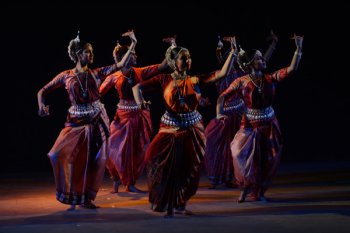 Nrityankan 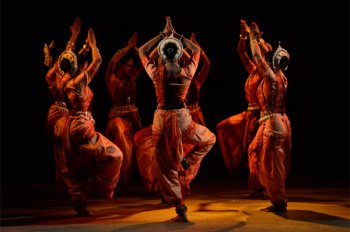 Odissi Rangakriti focuses on images and forms of color. The journey that Radha, the divine icon of human emotions, makes move through incarnations represented in different colors until she merges with dark Krishna. And in Savaro Rang Bheeji, Radha and Krishna play holi only to be smeared with the color of each other. Punaravrtta (rebirth) is a mystical piece with Radha in focus as the detached soul in love with Krishna, while the gopis are human, in love with life. Pradakshina is the consecration of time cycle. It depicts the eternal time through taal and laya in Kathak idiom. Various, intricate mathematical patterns woven into its footwork completes Pradikshna. Varna Riti is about the abstract concept of taal system. Tamaso Ma Jyotirgamaya is an artiste's journey to perfection and truth. The Odissi rendition of 'In search of Devi' is an attempt to comprehend the mystique of the female principle, divine in dimension, from Vedic to our own times of woman empowerment, in concepts ranging from mythical, historical and cultural traditions. Ritusamharam, based on the work of Kalidasa depicts the shades of the seasons in Odissi format. 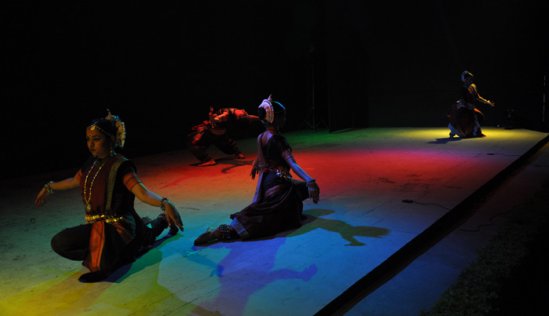 Parwati loves light design to add another dimension to a dance production, but laments the lack of infrastructure on Indian stage. Mahagami has documented Hindustani pakhawaj. The forthcoming dance production Vadya-Pallavi will be staged in Bhubaneswar in December. She is currently working on a book on Odissi taal system, a lost tradition. As a multi-talented Kathak and Odissi dancer, guru and researcher, Parwati Dutta is known as one of the finest thinking dancers. She has travelled extensively performing and conducting workshops in Hungary, Korea, Austria, China, Japan, Malaysia, Myanmar, Brazil, UK, France, Spain, Africa, to name some. BBC documented her work as an artiste in 1999. When asked to comment on a memorable experience, Parwati dwelt on the pain of dedication. She lost her father recently after a prolonged illness. In and out of hospitals, she tried to be with him all through a busy schedule. Father and daughter re-read the poems titled 'Rogashayya' that Rabindranath Tagore wrote during his last days. Soon after the demise of her father, she gave expression to those poems which touched the audience to tears: a daughter's obituary in visual poetry to her father. If the goal of life is the sense of fulfillment with a drive for excellence, Parwati Dutta, the artiste, is a role model. Parwati Dutta can be contacted at: parwatidutta@gmail.com Padma Jayaraj is a freelance writer on arts and travel and is a regular contributor to www.narthaki.com Post your comments Please provide your name and email id along with your comment. All appropriate comments posted with name and email id in the blog will also be featured in the site. |